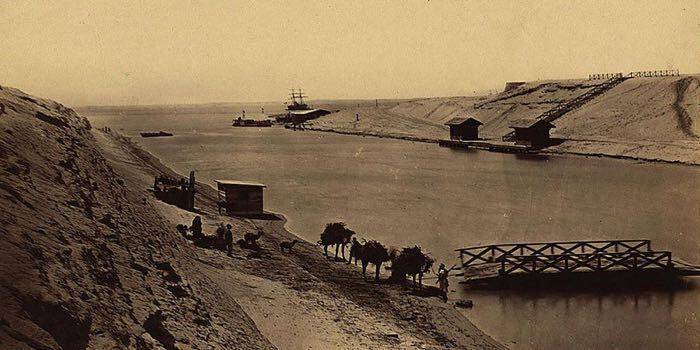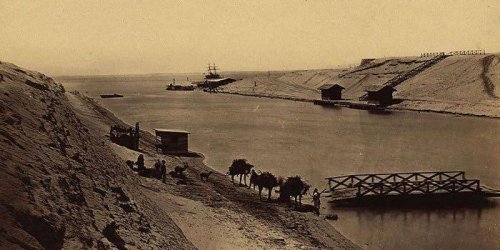“We have a complex from De Lesseps, from Cromer and from political occupation through the economy.” Those were the words of the late Egyptian president Gamal Abdel Nasser during his speech on the occasion of the nationalization of the Suez Canal in 1956. Nasser's bold decision led to the Tripartite war on Egypt on October 29, by Israel, France, and Britain.
History shows that it is justified for Egyptians to be sensitive when it comes to the Suez Canal considering the amount of sacrifices they gave for and around it. Since the Canal project started in 1859, the blood of almost 130,000 Egyptians has been spilled in it.
The Suez Canal is the artery that connects the Mediterranean to the Red Sea. It earns Egypt billions of dollars annually. It was inaugurated in November 1869 under the Khedive Ismail, ruler of Egypt at the time.
The French Ferdinand De Lesseps had convinced Abbas Pasha, the previous Egyptian ruler, to dig the canal. He founded a company to manage it and Egypt had a small share in it, earning 15% of the profits. Later the Egyptian state was forced to sell even this small share to Britain.
The digging was done by Egyptians and according to Nasser in his nationalization speech, 120,000 workers died during the digging. The book The Suez Canal… An Epic story of a People and the Dream of Generations published by the Ministry of Education in Egypt in 2014, claims that around 1 million Egyptian workers took part in the digging, and around 100 thousand died.
What explains this massive number is the inhumane treatment of the workers. French researcher Nathalie Montel in her book Le Chantier du Canal de Suez (1859-1869) translated by Egyptian historian Raouf Abbas, describes some of the difficulties for the workers such as lack of vital drinking water in the scorching desert heat. She explains that forced labor was a way to get Egyptian workers according to a decree by Said Pasha the ruler of Egypt at the time. About 10,000 workers would be brought in every month to work, and after 1861 the number reached 25,000.
The French researcher describes two lifestyles around the canal. The first involves restaurants, bakeries, alcohol shops, cafes, salons, and bars for the foreign elite, and the second is a miserable life for the forced laborers who would suffer from thirst, humiliation, and injustice.
According to medical records archived in the Library of Alexandria, the most common diseases among the workers were pulmonary diseases, cases of extreme diarrhea, dysentery, hepatitis, small pox, and tuberculosis. In the summer of 1865 cholera was added to this list and it was so deadly that the company could not get enough men to lift the bodies of the dead to be buried in the desert.
In addition to all this, workers were exposed to a liquid substance that contained burning phosphorous and led to thousands getting strange deadly diseases.
Workers would be filtered in the town of Al Zaqaziq: those who looked weak were rejected, those who were strong bodied would be sent on four day walk on foot to the canal while tied with ropes. Each had a bottle of water and a dry piece of bread. They would get to the digging areas exhausted and the old workers would be sent away after their one month planned stay.
The digging operation was an impressive scene that attracted foreign tourists.
The 193 km long canal was dug by hand, and Dr. Abdelaziz Al Shennawi, Histroy professor at Cairo University mentions in his book Forced Labor in the Digging of the Suez Canal that the Suez company did not bring any machines except for two tractors brought a month before the digging officially started. Despite the size and depth of the canal, the intention was clearly set to exploit the Egyptian people to dig it.
Tell El Kebir 1882
The Suez canal was one of the main causes for the British occupation of Egypt. After the rebellion of Defense Minister Ahmed Orabi against the Egyptian Khedive Tewfik, the latter convinced Britain to intervene militarily to stop Orabi. His pretext was that Orabi wanted to expel foreigners from Egypt, which would threaten Britain’s interests in the Nile valley, especially the Suez Canal. The United Kingdom had bought Egypt’s shares of the strategic canal that connected Britain to its colonies in the East.
In 1882 the British army bombed Alexandria and occupied it but they failed to get any further inside the country. They were defeated by the army and the people of Kafr Al Dawar. The British fleet abandoned Alexandria leaving behind a garrison and went to try and occupy Egypt from the East by going in from the Suez Canal from Port Said and then occupying Cairo.
In his book The History of Modern Egypt, Abdel Azim Ramadan argues that Ahmed Al Orabi, the leader of the Egyptian army, considered filling the canal to prevent the British from advancing to the Egyptian interior. He was tricked into changing his mind by Ferdinand De Lesseps, the president of the Suez Company at the time. De Lesseps convinced Orabi that Britain would not dare enter through the canal because it has a special international status and most of the company’s shares are owned by foreigners, mostly France. It was not allowed for military fleets to pass through. Orabi abandoned the idea but it appeared later that Lesseps tricked him.
On the 13th of September 1882, the Egyptian forces stationed in Tel El Kebir in Ismailia close to the canal were surprised to see the British coming with some Bedouins guiding them to the Egyptian army bases. Fierce battles would erupt reportedly lasting 30 minutes according to Abdel Azim Ramadan. 1396 Egyptian soldiers were killed, and 681 wounded, in addition to 57 British soldiers killed, 380 wounded and 22 were missing according to the British National Archive.
The Tripartite invasion 1956
On July 26, 1956, Gamal Abdel Nasser declared the nationalization of the Suez Canal, which was mostly owned by foreigners especially France and Britain. On October 29 of the same year, the Israeli forces attacked Sinai on the eastern shore of the canal, in coordination with France and Britain who deployed their forces on the Western shore. The Egyptian army confronting the Israeli army was surrounded. Abdel Nasser escaped the trap by ordering his troops to retreat from Sinai and to go back to the canal area. The Egyptians resorted to an unconventional war where army officers and popular resistance forces would coordinate in Port Said. The war ended in March 1957. A total of 3,000 Egyptians were killed in addition to 4,900 wounded.
The “Naksa” of June 1967
On June 5, 1967, Israel launched an attack on Egypt, Syria, and Jordan. Israel occupied the Sinai peninsula, the Eastern side of the canal. Between 9,800 and 15,000 Egyptian soldiers were killed or went missing during the war according to the memoirs of field marshal Mohamed Abdel Ghani el-Gamasy, the former minister of defense and commander of the land troops during the war. According to a report by the Red Cross however, the number of Egyptian causalities was 10,000.
The War of Attrition
After the 1967 defeat, the Egyptian army was stationed on the Western shore of the canal while the Israeli forces were on the Eastern one. The two sides engaged in a war of attrition in which 4,000 Egyptian soldiers lost their lives in addition to 10,000 civilians from the cities around Suez. According to the Red Cross casualties reached 14,000.
The October war 1973
On October 6, 1973, the Arab war for the liberation of the lands occupied by Israel started. The Egyptian forces crossed the canal and invaded the Eastern shore. The numbers of Egyptian causalities are a matter of controversy, some have said between five and 15,000, while the American historian and journalist Abraham Rabinovich says that the combined number of Syrian and Egyptian dead was 8,528, in addition to 19549 wounded. The Red Cross claims that the number of Egyptian casualties was 10000 dead, 2000 of which fell between the canal crossing on October 6 and 14. The rest died after the Egyptian army occupied the Madaik area in the center of Sinai until the cease fire on October 22, 1973.
Throughout all these episodes of exploitation and war around the Suez Canal, Egypt has lost around 130,000 lives directly or indirectly involved in the history of the Canal.
Raseef22 is a not for profit entity. Our focus is on quality journalism. Every contribution to the NasRaseef membership goes directly towards journalism production. We stand independent, not accepting corporate sponsorships, sponsored content or political funding.
Support our mission to keep Raseef22 available to all readers by clicking here!
Interested in writing with us? Check our pitch process here!






